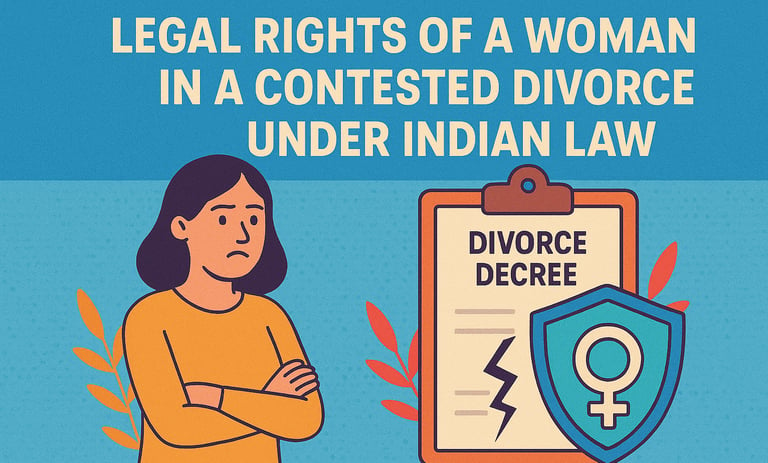Legal Rights of a Woman in a Contested Divorce Under Indian Law
A clear guide on women’s rights during contested divorce under Indian laws and court rulings.
FAMILY LAW
Ajay
7/9/20254 min read


A contested divorce occurs when one partner is not in agreement with the divorce petition, and the case will go to trial. This legal battle can be mentally and financially debilitating for women. However, the law in India provides many ways to guarantee protection for women, no matter what their religion may be. These fall into entitlements such as maintenance, residential rights, child custody, property matters, and protection against cruelty. This article will detail these entitlements clearly, with citation of relevant laws, significant judgments, and current developments.
1. Right to Maintenance and Alimony
1.1 Maintenance During Proceedings
Section 144 of the Bharatiya Nagarik Suraksha Sanhita (BNSS) allows any woman of any religion to claim interim support if she is unable to support herself.
Hindu Marriage Act, 1955 (Section 24) and Special Marriage Act, 1954 (Section 36): Allow women to claim temporary maintenance until the divorce case is resolved.
1.2 Permanent Alimony
Section 25 of the Hindu Marriage Act and Section 37 of the Special Marriage Act: the court can make a lump-sum payment or a periodic payment, depending on various things, including duration of marriage, age of parties, educational background, mental and physical health, conduct of the parties, and financial positions.
The Supreme Court has declared that for marriages over ten years, it is typically the case that entitles the party to lifelong support.
Recently, a woman was granted ₹50,000 per month as a permanent alimony, with a 5% adjustment after every two years.
1.3 Maintenance Rights for Muslim Women
The landmark Shah Bano case, Mohd. Ahmed Khan v. Shah Bano Begum, (1985) 2 SCC 556 [1]. Held that Muslim women can receive maintenance under Section 125 of the CrPC.
The Muslim Women (Protection of Rights on Marriage) Acts of 1986 and 2019 further give Muslim women rights relating to dower (mahr), support during the waiting period (iddat), and child expenses.
2. Right to Residence and Protection
2.1 Right to Reside
• According to the Protection of Women from Domestic Violence Act, 2005, women gain rights to remain in a shared household, even the Courts can inquire and enforce this right in favor of the woman alone if this is a safeguard should she and her child warrant enough reason to assume they were in danger.
2.2 Protection from Abuse
Legal orders are available to protect women against physical, sexual, emotional, and financial abuse.
Abuse will be taken into account by the court when deciding support, maintenance, and custody.
3. Child Custody and Visitation
A law encompassing all religions, the Guardians and Wards Act of 1890, helps courts ascertain what is in the best interests of the child when considering custody.
As per the Hindu Minority and Guardianship Act, the custody of daughters below the age of 7 and sons below the age of 5 is normally conferred to the mother.
The courts may also order both parents to jointly share custody or decide reasonable access or visitation rights to maintain a relationship with both parents.
4. Right to Stridhan and Property Claims
Stridhan includes gifts, jewelry, and any valuables given to the woman before, during, and after marriage. Stridhan is her property (lawfully her property after divorce).
The Supreme Court, in Krishna Bhattacharjee v. Sarathi Choudhury (2016) 2 SCC 705,[2] held that a woman can initiate criminal proceedings if she can't get her stridhan back.
Although India does not follow a system where all property has to be equally divided by both spouses, in divorce, courts can still order the division of property and issue a suitable settlement.
5. Grounds and Procedure in Contested Divorce
5.1 Legal Grounds (Under Hindu Law)
Common reasons a woman can file for divorce include:
Adultery
Cruelty (mental or physical)
Desertion for over two years
Religious conversion
Serious mental illness
Having a communicable disease
Bigamy (husband marrying another woman)
Presumed death
5.2 Steps in the Divorce Process
1. Filing the divorce petition with reasons
2. The court sends notice to the other spouse
3. Exchange of documents and evidence
4. Witnesses give statements and are questioned
5. Final arguments and the judge gives the decision
· After the court gives the divorce decree, a woman can still pursue maintenance, get back her stridhan, ask for changes in custody, or apply for protection orders.
6. Access to Legal Aid
The Legal Services Authorities Act, 1987, provides free legal help to women who can’t afford lawyers.
Bodies like National and State Legal Services Authorities (NLSA/SLSA) and Lok Adalats also help women through mediation, simple dispute resolution, and free legal services.
7. Recent Legal Developments
· Telangana High Court (June 2025) confirmed that Muslim women have the right to Khula (a form of divorce initiated by the wife), but stated that only courts—not religious bodies—can finalize it.
· The National Commission for Women (NCW) has started counselling centres to assist women facing divorce or domestic violence.
In Conclusion, despite even challenging contested divorces, Indian laws provide ample protections to women. These include financial maintenance, safe housing, free legal advice, custody rights, property rights, and freedom from violence. Whether through secular law through the BNSS and the Domestic Violence Act, or religion-based approaches through Hindu law or Muslim personal law, women have many options to protect their rights. In addition to protections that exist in law, courts have been affirming women’s rights through decisions that have been issued in recent years. Despite the challenges pertaining to slow processes and issues of social stigma, empowered women who are aware of the landscape can engage the legal process to advocate for justice with dignity and confidence.
[1] Mohd. Ahmed Khan v. Shah Bano Begum, (1985) 2 SCC 556
[2] Krishna Bhattacharjee v. Sarathi Choudhury, (2016) 2 SCC 705
